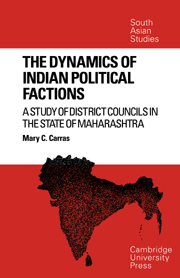Book contents
- Frontmatter
- Contents
- List of tables
- List of maps
- Acknowledgments
- 1 Introduction
- 2 The Argument
- 3 Political Integration: Empirical Conception and Method of Analysis
- 4 Ratnagiri District: Factional Alignments in Conditions of Poverty
- 5 Poona District: The Politics of Sugar
- 6 Aurangabad District: State versus District Leaders
- 7 Akola District: Factional Alignments in Conditions of Relative Plenty (The Politics of Cotton)
- 8 All Districts: Some Comparisons
- 9 Conclusion
- APPENDICES
- Notes
- Bibliography
- Index
6 - Aurangabad District: State versus District Leaders
Published online by Cambridge University Press: 23 November 2009
- Frontmatter
- Contents
- List of tables
- List of maps
- Acknowledgments
- 1 Introduction
- 2 The Argument
- 3 Political Integration: Empirical Conception and Method of Analysis
- 4 Ratnagiri District: Factional Alignments in Conditions of Poverty
- 5 Poona District: The Politics of Sugar
- 6 Aurangabad District: State versus District Leaders
- 7 Akola District: Factional Alignments in Conditions of Relative Plenty (The Politics of Cotton)
- 8 All Districts: Some Comparisons
- 9 Conclusion
- APPENDICES
- Notes
- Bibliography
- Index
Summary
SOCIAL AND ECONOMIC BACKGROUND OF POLITICAL CONFLICT
This district became a part of Maharashtra in 1956, with the enactment of the States Reorganization Act. Previously, it had been part of the State of Hyderabad which, until 1948, was under the rule of a prince descended from the Moghuls, the Nizam of Hyderabad. Its social and economic backwardness testify to the general neglect of public welfare by the prince. Thus, of the four districts studied, the Aurangabad Zilla Parishad was the only one whose president had completed only the fourth grade in primary school. Most of the other Presidents and Committee Chairmen had a college education, and quite a few held law degrees. In Aurangabad, only the Vice President had completed his college education; the educational level of the two remaining officeholders was similar to that of the President. The consequences of this often became painfully obvious during the meetings of the general body and the various committees, when none of the top elected officials (except the Vice President) could deal with any of the questions raised by members. The appointed administrative officers usually, in effect, conducted the meetings, rather than the elected representatives of the people. It was a situation which the opposition, both within and outside the Congress Party, could and did exploit to embarrass the ruling group within the Zilla Parishad.
While the district is socially backward (in terms of education, for example), it has considerable potential for economic development, particularly in agriculture and agro-industry.
- Type
- Chapter
- Information
- The Dynamics of Indian Political FactionsA Study of District Councils in the State of Maharashtra, pp. 104 - 128Publisher: Cambridge University PressPrint publication year: 1972



